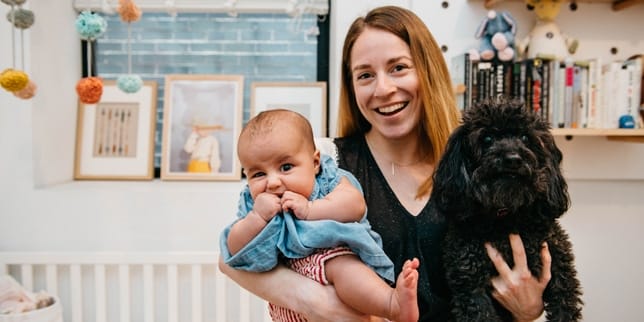Introducing your dog to your new baby

Tips to prep your pooch for baby.
Table of Contents
Are you getting ready to welcome your new bundle of joy? You and your partner may be excited, but the new arrival can be confusing and even frightening to your dog. After all, not only is baby a new (teeny tiny) person to get used to, he or she is also taking up all of your time and intention, which can lead your four-legged sidekick to grow jealous.
But don’t worry. The transition doesn’t have to be stressful, and with a few easy steps, not only can you get him ready for the change, but both of your babies can also become quick friends!
Introducing dog to baby is as easy as following these expert tips from Waggo and Leashrr.
Helpful tips to ensure your dog and new baby get along
1. Get loud
Before the baby arrives, start to simulate some of the new noises your dog might hear! Turn on the swing and mobile, play some baby music and let him become comfortable with all of the fun new things in your home.
2. Don’t assume
Don’t assume that your dog will be poorly behaved. Our canine friends can read your energy, and they show interest by sniffing and licking. When bringing your baby home, calmly greet your dog and let them smell a blanket or clothing that has been on the baby first so that they can become familiar with their scent. Then slowly introduce the baby. If your partner or family member can bring a hospital blanket to your pooch before the baby comes home, that will give him even more time to become familiar!
3. Let them bond
In the first few months, try to do a few activities a week that include both your dog and the baby. This can be anything from a long walk or a trip to the park. While being a new mom keeps you awfully busy, it’s good for everyone to get outside. So make it a family activity! The more your dog feels like they are part of your pack, the calmer they will be.
4. Draw boundaries
While doing things together is important, your pup should also have boundaries so that they know their limits from the get go. Your new baby is learning their environment, and it’s also great to give them their own space where they feel safe. Baby gates are an easy way to set physical boundaries for your dog, and making your baby’s room a dog-free zone will keep them safe as they continue to grow and become more interactive.
5. Use quick commands
Before the baby arrives, teach your dog some quick commands that will keep your baby safe and your dog calm. Training him to both “touch” and “go home” are easy commands that will come in handy. “Touch” can be taught by lowering your hand by your side and encouraging your dog to touch your hand with their nose (using a treat of course). The purpose is to be able to say “touch” at any moment and have your dog come to you if they are getting rambunctious. The “go home” command can be used to get your pup to go to their space, whether it’s their bed or a different room. If the baby is crying and the dog is jumping around, it’s a quick way to settle the dog and move them out of your way. This can be taught by pointing at their “home” and saying “go home” while throwing a treat in that direction. After some repetition, the dog will begin to associate you pointing at that area with “going home” and settling.
6. Stock up
This is a huge change for your canine friend, a lot of the anxiety that dogs have around new babies is the worry that they are being replaced or forgotten. Don’t forget to stock up on toys and give them new treats to burn some of that anxious energy when the baby arrives. Keeping a dog’s mind busy is the best thing to calm them!
7. Assess your dog
If your dog is overly excitable, aggressive or anxious then it might be a good idea to consult a professional dog trainer or behaviorist. They can provide guidance on introducing dog to baby.
8. Supervise all interactions
Don’t leave your pup and your baby alone together, especially in the beginning when they are still building trust. Being close by ensures that you can intervene whenever necessary.
9. Respect each other’s space
As your child grows older, it’s important to teach them to respect your dog’s space and vice versa. Show your child how to interact gently and discourage rough play.
10. Be patient and understanding
Like everything else, building this relationship will take time. Use positive reinforcement to reward your dog when they display good behavior around your baby. Understand that each dog is different but with patience and consistency you can foster a lifelong friendship between your dog and new baby.
A version of this post was published June 26, 2017. It has been updated.


































